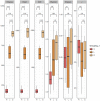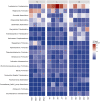Analysis and Comparison of Gut Microbiome in Young Detection Dogs
- PMID: 35516435
- PMCID: PMC9063727
- DOI: 10.3389/fmicb.2022.872230
Analysis and Comparison of Gut Microbiome in Young Detection Dogs
Abstract
The detection dogs are well-known for their excellent capabilities to sense different kinds of smells, which can play an important role in completing various searching and rescuing missions. The recent studies have demonstrated that the excellent olfactory function of detection dogs might be related with the gut microbes via the bidirectional communications between the gastrointestinal tract and the brain. In this study, the gut microbial communities of three types of breeds of detection dogs (Springer Spaniel, Labrador Retriever, and German Shepherd) were studied and compared. The results revealed that the richness and the diversity of gut microbiome German Shepherd dogs were significantly higher than the Labrador Retriever dogs and the Springer Spaniel dogs. At the phylum level, the most predominant gut microbial communities of the detection dogs were comprised of Fusobacteriota, Bacteroidetes, Firmicutes, Proteobacteria, Campilobacterota, and Actinobacteriota. At the genus level the most predominant gut microbial communities were comprised of Fusobacterium, Megamonas, Prevotella, Alloprevotella, Bacteroides, Haemophilus, Anaerobiospirillum, Helicobacter, Megasphaera, Peptoclostridium, Phascolarctobacterium, and Streptococcus. However, the gut microbial communities of the three dogs group were also obviously different. The mean relative abundance of Fusobacterium, Prevotella, Alloprevotella, Megamonas, Bacteroides, and Phascolarctobacterium presented significant differences in the three groups. According to the portraits and characteristics of the gut microbiome in young detection dogs, multiple kinds of nutritional interventions could be applied to manipulate the gut microbiota, with the aim of improving the health states and the olfactory performances.
Keywords: German Shepherd; Labrador Retriever; Springer Spaniel; detection dog; gut microbiota; olfactory function.
Copyright © 2022 Li, Sun, Li, Guan, Wei, Li, Liu, Shao, Mi, Liu, Qiu and Ma.
Conflict of interest statement
The authors declare that the research was conducted in the absence of any commercial or financial relationships that could be construed as a potential conflict of interest.
Figures








Similar articles
-
Comparative Analyses of the Gut Microbiota in Growing Ragdoll Cats and Felinae Cats.Animals (Basel). 2022 Sep 18;12(18):2467. doi: 10.3390/ani12182467. Animals (Basel). 2022. PMID: 36139326 Free PMC article.
-
Comparative analysis of gut microbiota of Chinese Kunming dog, German Shepherd dog, and Belgian Malinois dog.J Vet Sci. 2024 Nov;25(6):e85. doi: 10.4142/jvs.24181. J Vet Sci. 2024. PMID: 39608779 Free PMC article.
-
Composition and short-term stability of gut microbiota in lean and spontaneously overweight healthy Labrador retriever dogs.Acta Vet Scand. 2022 Mar 28;64(1):8. doi: 10.1186/s13028-022-00628-z. Acta Vet Scand. 2022. PMID: 35346308 Free PMC article.
-
The Gastrointestinal Microbiota of the Common Marmoset (Callithrix jacchus).ILAR J. 2020 Dec 31;61(2-3):188-198. doi: 10.1093/ilar/ilaa025. ILAR J. 2020. PMID: 33620078 Free PMC article. Review.
-
Gallstone Disease, Obesity and the Firmicutes/Bacteroidetes Ratio as a Possible Biomarker of Gut Dysbiosis.J Pers Med. 2020 Dec 25;11(1):13. doi: 10.3390/jpm11010013. J Pers Med. 2020. PMID: 33375615 Free PMC article. Review.
Cited by
-
Understanding the diversity and roles of the canine gut microbiome.J Anim Sci Biotechnol. 2025 Jul 5;16(1):95. doi: 10.1186/s40104-025-01235-4. J Anim Sci Biotechnol. 2025. PMID: 40615864 Free PMC article. Review.
-
Two Enterococcus faecium Isolates Demonstrated Modulating Effects on the Dysbiosis of Mice Gut Microbiota Induced by Antibiotic Treatment.Int J Mol Sci. 2024 May 15;25(10):5405. doi: 10.3390/ijms25105405. Int J Mol Sci. 2024. PMID: 38791443 Free PMC article.
-
Characterisation of the Faecal Microbiota in Dogs with Mast Cell Tumours Compared with Healthy Dogs.Animals (Basel). 2025 Jul 27;15(15):2208. doi: 10.3390/ani15152208. Animals (Basel). 2025. PMID: 40804998 Free PMC article.
-
Comparative Analyses of the Gut Microbiota in Growing Ragdoll Cats and Felinae Cats.Animals (Basel). 2022 Sep 18;12(18):2467. doi: 10.3390/ani12182467. Animals (Basel). 2022. PMID: 36139326 Free PMC article.
-
Limited day-to-day variation in the canine gut microbiota: implications for microbiome studies.Front Vet Sci. 2025 Jul 28;12:1632686. doi: 10.3389/fvets.2025.1632686. eCollection 2025. Front Vet Sci. 2025. PMID: 40792057 Free PMC article.
References
LinkOut - more resources
Full Text Sources

